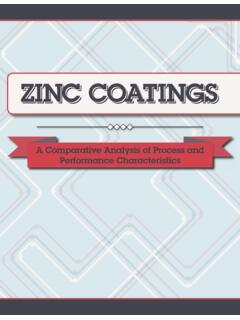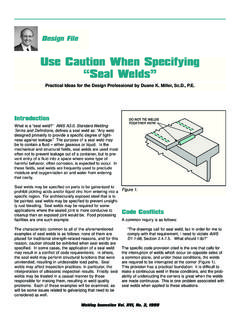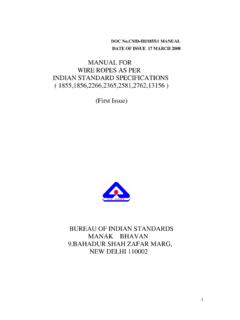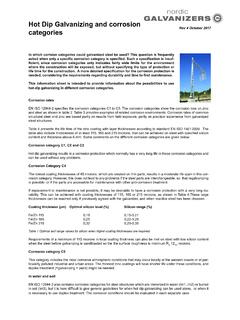Transcription of HOT-DIP GALVANIZING FOR CORROSION PROTECTION
1 HOT-DIP GALVANIZING FOR CORROSION PROTECTIONa specifier s guideamerican galvanizers associationAmerican Galvanizers Association2 2012 American Galvanizers Association. The material provided herein has been developed to provide accurate and authoritative information about after-fabrication HOT-DIP galvanized steel. This material provides general information only and is not intended as a substitute for competent professional examination and verification as to suitability and applicability. The information provided herein is not intended as a representation or warranty on the part of the AGA. Anyone making use of this information assumes all liability arising from such use. HOT-DIP GALVANIZING FOR CORROSION PROTECTIONa specifier s guideCorrosion What & WhyCorrosion ProcessHot-Dip GALVANIZING (HDG) HistoryProcessWhy Specifiers Choose HDGC orrosion ProtectionBarrier, Cathodic, Zinc PatinaDurabilityAbrasion ResistanceUniform ProtectionComplete CoverageLongevity AtmosphereSoilWaterConcrete Other EnvironmentsAvailability & VersatilityAbundant MaterialsEfficiencyFlexibilityAesthetics Natural/BlendingArchitectural ApplicationsDuplex SystemsSustainabilityEnvironmentalEconom icSpecifying HDGC onclusionAmerican Galvanizers Association3 CORROSION :what & why CORROSION and repair of CORROSION damage are multi-billion dollar problems the latest estimates show metallic CORROSION costs the United States approximately $423 billion annually ($52 billion in Canada), or about 3% of each nation s GDP.
2 However, the cost of CORROSION is much greater than just financial, it can also lead to waste of natural resources, hazardous failures, and many other indirect costs. CORROSION is a natural phenomenon which can never be completely eliminated; however, it is a misconception nothing can be done. Employing adequate CORROSION PROTECTION systems at the start of a project, such as HOT-DIP GALVANIZING , can significantly reduce these annual costs. For more than 100 years, HOT-DIP GALVANIZING after fabrication has been specified to combat steel CORROSION in the harshest environments throughout various markets. However, the specification and use of HOT-DIP galvanized steel evolves constantly as new markets emerge. Once considered only as a means of CORROSION PROTECTION , HOT-DIP GALVANIZING is now specified for an array of reasons including lower initial cost, durability, longevity, availability, versatility, sustainability, and even aesthetics. Understanding the characteristics and performance of HOT-DIP galvanized steel will facilitate and increase the specification of the coating in applications where GALVANIZING will enhance the processCorrosion, which can be simply defined as rust, is more appropriately the tendency for metals to revert to their natural, lower energy state of ore.
3 Metallic CORROSION is an electrochemical process meaning it involves both chemical reactions and the flow of electrons. A basic electrochemical process that drives the CORROSION of metals is galvanic action, where current is generated internally by physical and chemical reactions occurring among the components of the cell. CORROSION costs the US$423 BILLION annuallyAmerican Galvanizers Association4galvanic corrosionThere are two primary types of galvanic cells that cause CORROSION : the bimetallic couple and the concentration cell. A bimetallic couple (Figure 1) is like a battery, consisting of two dissimilar metals immersed in an electrolyte solution. An electric current (flow of electrons) is generated when the two electrodes are connected by an external continuous metallic path. A concentration cell consists of an anode and cathode of the same metal or alloy and a return current path. The electromotive force is provided by a difference in concentration of the solutions contacting the metal(s).
4 In a galvanic cell, there are four elements necessary for CORROSION to occur: Anode - Electrode at which negative ions are discharged and positive ions are formed, or other oxidizing reactions occur. CORROSION occurs at the anode. Cathode - Electrode at which positive ions are discharged, negative ions are formed, or other reducing reactions occur. The cathode is protected from CORROSION . Electrolyte - Conducting medium in which the flow of current is accompanied by movement of matter. Electrolytes include water solutions of acids, bases, and salts. Return Current Path - The metallic pathway connecting the anode to the cathode. It is often the underlying any one of these elements will stop the current flow and CORROSION will not occur. Substituting a different metal for the anode or cathode may cause the direction of the current to reverse, resulting in a change of the electrode experiencing galvanic series lists metals and alloys in decreasing order of electrical activity.
5 Metals toward the top of the list are less noble and have a greater tendency to lose electrons than metals found lower on the list. Utilizing HOT-DIP galvanized steel exploits this phenomenon by sacrificing zinc (anode) to protect the underlying steel (cathode). CORROSION of steelThe CORROSION process that takes place on a piece of bare steel is very complex due to variations in the composition/structure of the steel, presence of impurities due to the higher instance of recycled steel, uneven internal stress, or exposure to a non-uniform environment. It is easy for microscopic areas of the exposed metal to become relatively anodic or cathodic, and many of these areas can develop in a small section of the exposed metal. Therefore, it is highly possible several different galvanic CORROSION cells are present in the same small area of the actively corroding piece of steel. +-ExternalCircuitElectrolyteCONVENTIONAL CURRENTE lectronsElectronsAnodeCathodeFigure 1: Bimetallic CoupleAmerican Galvanizers Association4 American Galvanizers Association5 HOT-DIP GALVANIZING (HDG)As the CORROSION process progresses, the electrolyte may change due to materials dissolving in or precipitating from the solution.
6 Additionally, CORROSION products might tend to build up on certain areas of the metal. As time goes by, there may be a change in the location of cathodic and anodic areas and previously uncorroded areas of the metal are attacked and corrode (Figure 2).The CORROSION rate of metals is controlled by factors such as temperature, humidity, pH of the electrolyte, and the electrical potential and resistance of anodic and cathodic CORROSION protectionHot-dip GALVANIZING is the process of immersing fabricated steel or iron into a kettle or bath of molten zinc. The process is inherently simple which provides a distinct advantage over other CORROSION PROTECTION methods. Originating more than 250 years ago, here is a tour of the history and process in more detail. history of galvanizingThe recorded history of GALVANIZING dates back to 1742 when Malouin, a French chemist described a method of coating iron by dipping it in molten zinc in a presentation to the French Royal Academy.
7 Thirty years later, Luigi Galvani, GALVANIZING s namesake, discovered more about the electrochemical process that takes place between metals. Galvani s research was furthered in 1829 when Michael Faraday discovered zinc s sacrificial action, and in 1836, French engineer Sorel obtained a patent for the early GALVANIZING process. By 1850, the British GALVANIZING industry was using 10,000 tons of zinc a year for the PROTECTION of steel, and in 1870, the first GALVANIZING plant opened in the United States. Today, GALVANIZING is found in almost every major application and industry where iron or steel is used. HOT-DIP galvanized steel has a proven and growing history of success in myriad applications worldwide. Figure 2: Changes in cathodic and anodic areasCACCAAACAACCCACCAAM osaic of anodes and cathodes, electrically connected by the underlying in the air provides the electrical path between anodes and cathodes.
8 Due to differences in potential, electric current begins to flow as the anodic areas are consumed. Iron ions produced at the anode combine with the environment to form the flaky iron oxide known as anodic areas corrode, new material of different composition and structure is exposed. This results in a change of electrical potentials and changes the location of anodic and cathodic sites. Over time, previously uncorroded areas are attacked and uniform surface CORROSION results. This continues until the steel is entirely Galvanizers Association5 American Galvanizers Association6galvanizing processThe GALVANIZING process consists of three basic steps: surface preparation, GALVANIZING , and inspection (Figure 3.)surface preparationSurface preparation is the most important step in the application of any coating. In most instances where a coating fails before the end of its expected service life, it is because of incorrect or inadequate surface preparation. The surface preparation step in the GALVANIZING process has its own built-in means of quality control because zinc simply will not react with unclean steel.
9 Any failures or inadequacies in surface preparation will be immediately apparent when the steel is withdrawn from the zinc bath because the unclean areas will remain uncoated, and immediate corrective action can be taken. Surface preparation for GALVANIZING consists of three steps: Degreasing - A hot alkali solution, mild acidic bath, or biological cleaning bath removes organic contaminants such as dirt, paint markings, grease, and oil from the metal surface. Epoxies, vinyls, asphalt, or welding slag, which cannot be removed by degreasing, must be removed before GALVANIZING by grit-blasting, sand-blasting, or other mechanical means. Pickling A dilute solution of heated sulfuric acid or ambient hydrochloric acid removes mill scale and iron oxides (rust) from the steel surface. As an alternative to or in conjunction with pickling, this step can also be accomplished using abrasive cleaning or air blasting sand, metallic shot, or grit onto the steel.
10 Fluxing The final surface preparation step in the GALVANIZING process, a zinc ammonium chloride solution, serves two purposes. It removes any remaining oxides and deposits a protective layer on the steel to prevent any further oxides from forming on the surface prior to immersion in the molten zinc. galvanizingDuring the actual GALVANIZING step of the process, the material is completely immersed in a bath of molten zinc. The bath chemistry is specified by ASTM B6, and requires at least 98% pure zinc maintained at approximately 840 F (449 C). While immersed in the kettle, the zinc reacts with the iron in the steel to form a series of zinc/iron intermetallic alloy layers. Once the fabricated items coating growth is complete, they are withdrawn slowly from the GALVANIZING bath, and the excess zinc is removed by draining, vibrating, and/or metallurgical reaction will continue after the articles are withdrawn from the bath, as long as the article remains near bath temperature.












